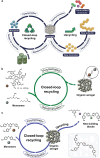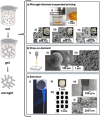Review and Perspectives on the Sustainability of Organic Aerogels
- PMID: 40463996
- PMCID: PMC12128215
- DOI: 10.1021/acssuschemeng.4c09747
Review and Perspectives on the Sustainability of Organic Aerogels
Abstract
Aerogels are exceptionally lightweight materials characterized by their high open porosity and remarkable specific surface area, currently used across a wide array of industrial sectors from construction to energy storage and have great potential for expanding their applicability and unlocking new market opportunities. Driven by global economic growth and an intensifying environmental crisis, there is a growing demand for engineering innovations that prioritize sustainability. Aerogels are well-positioned to support these sustainability efforts. Their unique properties make them ideal for energy-saving solutions, environmental remediation, and more efficient use of resources. As the demand for eco-conscious technologies rises, aerogels are poised to contribute significantly to the development of greener, more efficient products and processes across multiple industries. The sustainability of aerogel technology is crucial for the mid-to-long-term future, yet its current status has been scarcely reviewed in the literature. This Perspective explores and critically reviews significant advances on organic and hybrid aerogels in the current socioeconomic scenario, with selected case studies endorsing their contribution to the UN Sustainable Development Goals. It also identifies research gaps while proposing innovative strategies to enhance the sustainability of aerogel production through the application of circular economy principles. Key strategies discussed involve the fabrication of aerogels using eco-friendly sources, such as biopolymers derived from biorefinery processes or from waste materials. Additionally, this Perspective examines the development of methods for the reuse, recycling, and end-of-life management of aerogels, along with the implementation of more efficient processing routes. Ultimately, this work highlights the need for comprehensive assessments of aerogel sustainability through life cycle assessment (LCA) and evaluations of safety and toxicity. By addressing these critical aspects, the potential of aerogels to contribute to a more sustainable future appears highly favorable from both commercial and research perspectives, paving the way for a circular aerogel economy and providing a lasting impact to the society in which we live.
Keywords: aerogel recycling; bioaerogels; circular technologies; sustainable production; waste upcycling.
© 2025 American Chemical Society.
Figures







References
-
- Strategic Energy Technology Plan; https://energy.ec.europa.eu/topics/research-and-technology/strategic-ene... (accessed 2024–09–03).
-
- Critical raw materials - European Commission; https://single-market-economy.ec.europa.eu/sectors/raw-materials/areas-s... (accessed 2024–09–03).
-
- Enhancing cooperation with Japan on critical raw materials supply chains through a new Administrative Arrangement - European Commission; https://single-market-economy.ec.europa.eu/news/enhancing-cooperation-ja... (accessed 2024–09–12).
-
- Critical Raw Materials Act - European Commission; https://single-market-economy.ec.europa.eu/sectors/raw-materials/areas-s... (accessed 2024–09–12).
-
- Nakano, J. The Geopolitics of Critical Minerals Supply Chains; Center for Strategic and International Studies (CSIS), 2021; pp 19–22. https://www.jstor.org/stable/resrep30033.8 (accessed 2024–09–12).
Publication types
LinkOut - more resources
Full Text Sources
Research Materials
